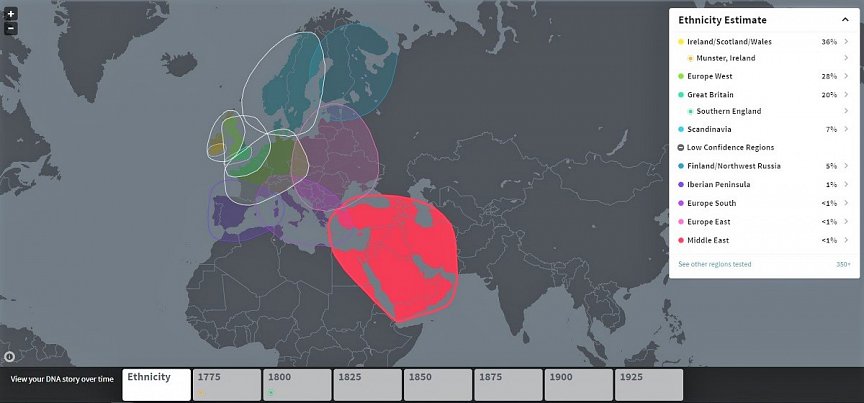Ancestry DNA results
Recently my Ancestry DNA results changed. Not because my DNA actually changed (that's only possible over a lifetime through radiation, diet, and other factors of epigenetics), but because their database has been updated. In the past Ancestry relied too much on ethnic and socio-political constructs of the last 500 to 1,000 years. For example, they used France, Southern Europe, Eastern Europe, Scandinavia, and the Caucasus just as a few examples of "regions" they tested. Here are a couple pictures of other people's DNA results I found on the web just to show an example.
Southern Europe, Caucusus, Middle East, Eastern Europe.
Scandinavia, the Middle East, Great Britain, Ireland and Scotland, Western Europe.
These are mine now before and after:
It now says I am 50% Germanic, eliminated all my non-existent Scandinavian, Caucasus (origin of Caucasian), and Europe South DNA. It also added some Irish and Scottish which I did not know about. I'm also 3% more Eastern European/Russian! Whoa! Shocker! This is why people should not trust their ethnicity ESTIMATES. They change with time, and with such a small original non-representative sample (middle class Americans and Europeans), it is most definitely going to change over the next several years. But there are still things to learn from these datasets! Ancestry and Nature published a paper recently about the genetic groupings of the United States.
I feel like this ethnicity ESTIMATE makes more sense than my original ESTIMATE because of history. The Germanic tribes which comprised the future Anglo-Saxons (Great Britain), the Scandinavians who would go on to conquer large parts of England and France (the Danelaw and Normandy), came in about 2,000 years ago and started settling the lands north of the Roman Empire and Rhine. The Slavs, a distant relative on the Indo-European tree, started migrating from Kazakhstan about the same time to the Ukraine, and eventually spread from there. What Ancestry might have done, if what it says is true, is scrape DNA evidence from those migrations 2,000 years ago, and their descendants moving back and forth. This would be super amazing--since languages, cultures, and religions change faster than the average human reproduction rate, thus allowing the slow transmission of genes in human populations. Using more test areas and having better sequencing techniques has hopefully allowed Ancestry to use the genetics of the past to prove traditionally known migrations from the past, or has Ancestry simply made the genetics fit the history?
Any thoughts?
Southern Europe, Caucusus, Middle East, Eastern Europe.
Scandinavia, the Middle East, Great Britain, Ireland and Scotland, Western Europe.
These are mine now before and after:
It now says I am 50% Germanic, eliminated all my non-existent Scandinavian, Caucasus (origin of Caucasian), and Europe South DNA. It also added some Irish and Scottish which I did not know about. I'm also 3% more Eastern European/Russian! Whoa! Shocker! This is why people should not trust their ethnicity ESTIMATES. They change with time, and with such a small original non-representative sample (middle class Americans and Europeans), it is most definitely going to change over the next several years. But there are still things to learn from these datasets! Ancestry and Nature published a paper recently about the genetic groupings of the United States.
I feel like this ethnicity ESTIMATE makes more sense than my original ESTIMATE because of history. The Germanic tribes which comprised the future Anglo-Saxons (Great Britain), the Scandinavians who would go on to conquer large parts of England and France (the Danelaw and Normandy), came in about 2,000 years ago and started settling the lands north of the Roman Empire and Rhine. The Slavs, a distant relative on the Indo-European tree, started migrating from Kazakhstan about the same time to the Ukraine, and eventually spread from there. What Ancestry might have done, if what it says is true, is scrape DNA evidence from those migrations 2,000 years ago, and their descendants moving back and forth. This would be super amazing--since languages, cultures, and religions change faster than the average human reproduction rate, thus allowing the slow transmission of genes in human populations. Using more test areas and having better sequencing techniques has hopefully allowed Ancestry to use the genetics of the past to prove traditionally known migrations from the past, or has Ancestry simply made the genetics fit the history?
Any thoughts?





Comments
Post a Comment